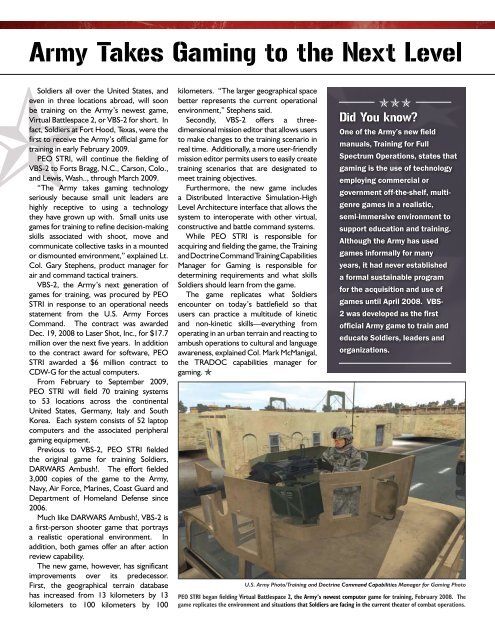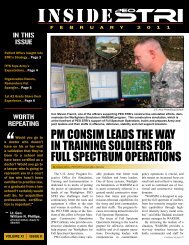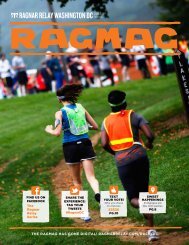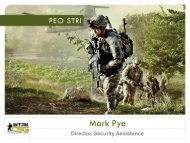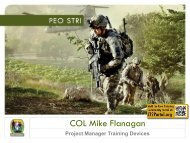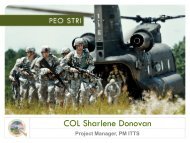Inside STRI Special Edition January - February 2009 (PDF)
Inside STRI Special Edition January - February 2009 (PDF)
Inside STRI Special Edition January - February 2009 (PDF)
Create successful ePaper yourself
Turn your PDF publications into a flip-book with our unique Google optimized e-Paper software.
Army Takes Gaming to the Next Level<br />
Soldiers all over the United States, and<br />
even in three locations abroad, will soon<br />
be training on the Army’s newest game,<br />
Virtual Battlespace 2, or VBS-2 for short. In<br />
fact, Soldiers at Fort Hood, Texas, were the<br />
first to receive the Army’s official game for<br />
training in early <strong>February</strong> <strong>2009</strong>.<br />
PEO <strong>STRI</strong>, will continue the fielding of<br />
VBS-2 to Forts Bragg, N.C., Carson, Colo.,<br />
and Lewis, Wash.., through March <strong>2009</strong>.<br />
“The Army takes gaming technology<br />
seriously because small unit leaders are<br />
highly receptive to using a technology<br />
they have grown up with. Small units use<br />
games for training to refine decision-making<br />
skills associated with shoot, move and<br />
communicate collective tasks in a mounted<br />
or dismounted environment,” explained Lt.<br />
Col. Gary Stephens, product manager for<br />
air and command tactical trainers.<br />
VBS-2, the Army’s next generation of<br />
games for training, was procured by PEO<br />
<strong>STRI</strong> in response to an operational needs<br />
statement from the U.S. Army Forces<br />
Command. The contract was awarded<br />
Dec. 19, 2008 to Laser Shot, Inc., for $17.7<br />
million over the next five years. In addition<br />
to the contract award for software, PEO<br />
<strong>STRI</strong> awarded a $6 million contract to<br />
CDW-G for the actual computers.<br />
From <strong>February</strong> to September <strong>2009</strong>,<br />
PEO <strong>STRI</strong> will field 70 training systems<br />
to 53 locations across the continental<br />
United States, Germany, Italy and South<br />
Korea. Each system consists of 52 laptop<br />
computers and the associated peripheral<br />
gaming equipment.<br />
Previous to VBS-2, PEO <strong>STRI</strong> fielded<br />
the original game for training Soldiers,<br />
DARWARS Ambush!. The effort fielded<br />
3,000 copies of the game to the Army,<br />
Navy, Air Force, Marines, Coast Guard and<br />
Department of Homeland Defense since<br />
2006.<br />
Much like DARWARS Ambush!, VBS-2 is<br />
a first-person shooter game that portrays<br />
a realistic operational environment. In<br />
addition, both games offer an after action<br />
review capability.<br />
The new game, however, has significant<br />
improvements over its predecessor.<br />
First, the geographical terrain database<br />
has increased from 13 kilometers by 13<br />
kilometers to 100 kilometers by 100<br />
kilometers. “The larger geographical space<br />
better represents the current operational<br />
environment,” Stephens said.<br />
Secondly, VBS-2 offers a threedimensional<br />
mission editor that allows users<br />
to make changes to the training scenario in<br />
real time. Additionally, a more user-friendly<br />
mission editor permits users to easily create<br />
training scenarios that are designated to<br />
meet training objectives.<br />
Furthermore, the new game includes<br />
a Distributed Interactive Simulation-High<br />
Level Architecture interface that allows the<br />
system to interoperate with other virtual,<br />
constructive and battle command systems.<br />
While PEO <strong>STRI</strong> is responsible for<br />
acquiring and fielding the game, the Training<br />
and Doctrine Command Training Capabilities<br />
Manager for Gaming is responsible for<br />
determining requirements and what skills<br />
Soldiers should learn from the game.<br />
The game replicates what Soldiers<br />
encounter on today’s battlefield so that<br />
users can practice a multitude of kinetic<br />
and non-kinetic skills—everything from<br />
operating in an urban terrain and reacting to<br />
ambush operations to cultural and language<br />
awareness, explained Col. Mark McManigal,<br />
the TRADOC capabilities manager for<br />
gaming. <br />
Did You know?<br />
One of the Army’s new field<br />
manuals, Training for Full<br />
Spectrum Operations, states that<br />
gaming is the use of technology<br />
employing commercial or<br />
government off-the-shelf, multigenre<br />
games in a realistic,<br />
semi-immersive environment to<br />
support education and training.<br />
Although the Army has used<br />
games informally for many<br />
years, it had never established<br />
a formal sustainable program<br />
for the acquisition and use of<br />
games until April 2008. VBS-<br />
2 was developed as the first<br />
official Army game to train and<br />
educate Soldiers, leaders and<br />
organizations.<br />
U.S. Army Photo/Training and Doctrine Command Capabilities Manager for Gaming Photo<br />
PEO <strong>STRI</strong> began fielding Virtual Battlespace 2, the Army’s newest computer game for training, <strong>February</strong> 2008. The<br />
game replicates the environment and situations that Soldiers are facing in the current theater of combat operations.


